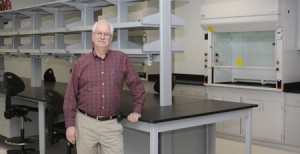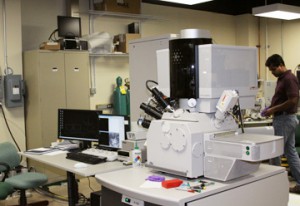BY ANDREW MOORE
Reporter with Silicon Hills News

STAR park Executive Director Stephen Frayser in the STAR one labs. Photos by Samantha Davis
How does a small or mid-sized company create a product on the cutting edge of material science or nano-technology? Not only would they need to acquire or rent multi-million dollar equipment, but they would need access to dedicated lab space and support staff. Traditionally, companies would need to relocate to Silicon Valley to access these resources – but soon, those same companies will have the option of going to Texas State University.
Texas State University has just opened its new
Science, Technology, and Advanced Research Park – or STAR Park for short. The park is 38 acres and about five minutes from campus. The university dedicated the first facility of the park — STAR One– on Nov. 9, though the building is not yet ready for occupancy. The park is funded by Texas State University, the Economic Development Administration of the U.S. Department of Commerce, and the city of San Marcos. It is a $7 million investment, and a central part of Texas State’s plan to move toward becoming a tier one research university.
Texas State University’s Associate VP for Research and Federal Relations Bill Covington says that the STAR Park benefits the university and its students as well as the local economy.
“Any time we bring in a company that gets started and starts hiring people it’s good for the economic development for the area,” says Covington.
STAR Park Executive Director Stephen Frayser says the goal of the park is to create a technology incubator and a collaborative community of startups and mid-sized companies that will be able to grow quickly by using Texas State’s unique resources.
“The whole purpose of an incubator is time-to-market,” says Frayser. “What you are trying to do is help companies get the assistance that they need at the time they need it so they can get into the market more efficiently than a competitor that had no assistance.”
STAR One will be ready for occupancy by April. The 20,000-square-foot facility has office space, a conference room, and five lab areas that include chemical labs and clean rooms. When completed, it will be 38,000-square-feet, hold six additional labs, and will host up to 11 companies. Labs in STAR One come with de-ionized water, nitrogen, and compressed air. The facility is also equipped with back-up power and provides waste removal services on site at a reduced cost.
Three companies are already scheduled to move into the new facility in April. MicroPower Global, one of these companies, has already been collaborating with the university research faculty for three years and will now be able to move ahead with their product.
“We have identified an ideal situation where our technology can be finally developed as an embedded company on the campus of Texas State University,” says MicroPower Global’s Chief Technology Officer Tom Zirkle. “STAR One provides us an opportunity to pull that developed technology into pilot production.”

Multi-functional Materials Laboratory
MicroPower Global will also have access to the $7 million Multi-functional Materials Laboratory located on the Texas State University campus. Startups and mid-size companies alike will have access to this top-of-the-line equipment — in addition to STAR Park faculties — once they sign research agreements with the university. The laboratory gives Texas Statue University a major advantage in attracting companies that are on the cutting edge of semiconductor technology.
“Our niche right now in the market is material sciences, nano-materials, and semi conductors — and we have a core staff of people and some fairly deep facilities here that let us stand out from anybody else in the U.S.,” says Frayser.
The different material laboratories at Texas State University currently allow companies to do research at almost the same level as in Silicon Valley. Texas State’s Molecular Beam Epitaxy machine — or MBE – allows them to do advanced research on nano-sized semiconductor materials for extremely small and versatile computer chips. The labs can also create membranes, adhesives, and very simple nano-machines. Companies and startups working at STAR One will be able to use this advanced equipment at the university to do their research and produce prototype technologies – all at a greatly reduced cost versus renting the equipment on the open market.

Labs have equipment that can create Nano-sized objects.
These resources are not available to just any interested company, however; there are two requirements for companies that use the facility. First, the company must be developing a unique technology – or one that is not an extension or addition to another technology already on the market. Secondly, the company must have an arrangement that is mutually beneficial to Texas State University, such as a partnership with university faculty or an agreement to utilize Texas State University students as interns.
MicroPower Global has already hired several full time employees from inside the university and currently has six TXST interns doing research for the company. CTO Zirkle says the interns play a major role in the companies’ research.
“They actually have hands on experience doing the very precise processing of the semi-conducter devices that we’re developing,” says Zirkle. “They have an opportunity to have exposure to how a small business operates — how an entrepreneurial environment feels. As we are developing new ideas to solve problems, they actively participate with us in those problem solving sessions.”
Putting students in these hands-on research roles is a key part of the STAR Park’s mission. TXST has already established a Material Science, Engineering and Commercialization PH.D. program — or MSEC — for the purpose of educating students in both the science side and business side of creating a technology company. Park Director Frayser says these students will be ideal candidates for internship positions with companies staying at STAR One.
“One of the biggest complaints businesses have of people they hire from universities is that they have no concept beyond theory of how things really work,” says Frayser. “This intention is to get our graduates to a point where they can become key individuals with firms. One of our Ph.D.s has already been hired by MicroPower to be one of their chief scientists. ”
Frayser says the STAR Park has already generated interest with several other parties besides the three firms coming in April. All companies and startups accepted to the park will pay the market rate for similar lab and office space. Frayser says that the park will try to admit companies that can complement each other as the park develops. Administrators will also help facilitate collaboration between their tenant companies by assessing the strengths and needs of their tenants to help them form mutually beneficial partnerships.
“We have individual companies but then we are going to encourage collaboration where it makes sense to work together on things,” says Frayser. “We want to create a community.”
Though not all research parks are successful, both Frayser and Covington are very optimistic about the future of technology in the San Marcos area.
“I think we are doing this at the right time and in the right way, and we are certainly in a great location in the state of Texas,” says Covington.
![]() What is the best time for students to be exposed to entrepreneurship and tech careers? Early College? High School? San Antonio nonprofit Venturelab is giving kids hands on experience with entrepreneurship and product invention as early as age 10.
What is the best time for students to be exposed to entrepreneurship and tech careers? Early College? High School? San Antonio nonprofit Venturelab is giving kids hands on experience with entrepreneurship and product invention as early as age 10.